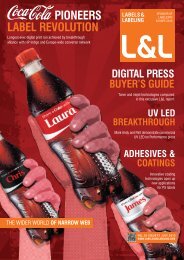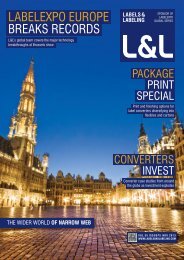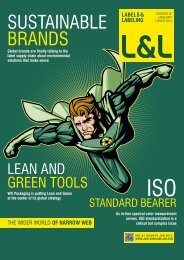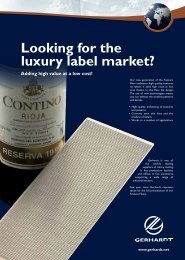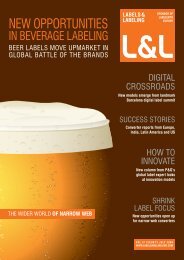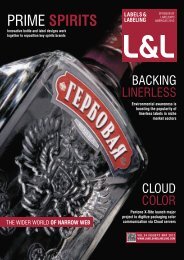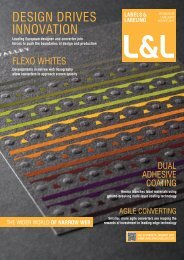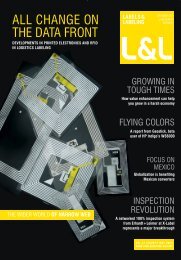SELL
Download - Labels & Labeling
Download - Labels & Labeling
- No tags were found...
You also want an ePaper? Increase the reach of your titles
YUMPU automatically turns print PDFs into web optimized ePapers that Google loves.
LABELS&LABELING |51<br />
Toying with the label<br />
LEADING SPANISH CONVERTER Germark has worked hard with its industry partners to help a shampoo<br />
manufacturer recapture lost market share. Carol Houghton reports<br />
In tough economic times, brand owners’ natural reflex is to<br />
try and cut their labeling costs. But Barcelona based label<br />
converter Germark prefers to offer them another, more<br />
creative route to profitability. Germark began to speak to<br />
facestock suppliers four years ago, when it invested in a<br />
production line to both manufacture and print its own pressure-sensitive<br />
labels. This is where its relationship with film<br />
specialist ExxonMobil Chemical, began.<br />
Coinciding with the start of the global financial crisis in<br />
2009, one of Germark’s biggest customers, Denenes,<br />
reported it was struggling with its sales of health and beauty<br />
products. It approached Germark looking for a way to reduce<br />
labeling costs. Iban Cid, president, Germark says, ‘this was<br />
not the answer.’ He believed that label price was not the issue<br />
and instead proposed an innovative promotional project<br />
which would allow the company to increase its market share.<br />
Cid outlines two routes for bringing innovation to the market.<br />
Firstly, by responding to a customer’s idea – for example<br />
one customer required development of an edible pressure<br />
sensitive label (eventually abandoned because of cost). The<br />
other option is to use in-house R&D to bring new products to<br />
the market, an excellent example is the Peel Stick and Play<br />
(PSP) promotional labeling system. ‘We are pushing R&D to<br />
create new solutions in the recession to help our customers,’<br />
adds Cid.<br />
In the case of Denenes, Germark worked with ExxonMobil<br />
to develop an innovative promotional label for the HDPE<br />
(high density polyethylene) bottle Denenes used for its children’s<br />
shampoo. The labels feature a three layer construction,<br />
which can all be separated during use. The first layer is<br />
peeled off to reveal a middle layer of die-cut stickers which<br />
can be removed and replaced whilst the primary brand label<br />
remains completely intact. Cid says ‘ExxonMobil’s Label-Lyte<br />
OPP Films for PSL enabled us to convert the bottle of shampoo into<br />
a toy.’ The mechanical strength and tear properties mean the die-cut<br />
stickers can be simply and cleanly separated and reapplied many<br />
times, providing hours of entertainment for children.<br />
The construction provides the brand with a key differentiator from<br />
its competitors in a crowded market. and, importantly for its target<br />
audience, is fun. Cid says, ‘With very little cost increase, there is a<br />
lot of value added across the value chain.’ Denenes reported that<br />
the PSP label application increased sales of its shampoo by a staggering<br />
12 percent.<br />
THE TECHNOLOGY<br />
The labels are printed in two steps; firstly the three layers are printed<br />
on an MPS EP-410 UV flexo press. The base layer is a 5-color job<br />
plus release varnish, the stickers are printed with three colors and<br />
the cover is printed with five colors plus pattern adhesive at 40<br />
meters per minute. Construction and converting of the complex<br />
laminate is done offline on an ETI Cohesio machine. Both ETI and<br />
MPS machines have print widths up to 410mm. The label is applied<br />
at the brand’s packaging facilities with a regular self-adhesive label<br />
applicator made by Germark.<br />
In terms of conversion properties, Iban Cid reports that Label-Lyte<br />
provides excellent printability and adhesive receptivity, stiffness and<br />
flex resistance, very good moisture resistance and good overall<br />
converting, die-cutting and dispensing properties. The high opacity<br />
of the film allows printing on multiple layers, preserving the quality<br />
of the primary label and hiding the stickers of the second layer. The<br />
film also provides good stiffness for easy dispensing, separating and<br />
handling of labels and stickers. Cid adds, ‘Stiffness was a key element<br />
of the product which is why using OPP was so important.’<br />
Sustainability is also an element of the design, as Germark converts<br />
its PS material with a PET liner, which is fully recyclable and<br />
allows 25 percent more labels to be printed per roll.<br />
(L-R) Kevin Frydryk, global market development<br />
manager, labels, ExxonMobil Chemical OPP films<br />
business, Michele Fiori, southern Europe manager,<br />
labels, ExxonMobil Chemical Iberia S.L. OPP films<br />
business and Iban Cid, managing director, Germark<br />
JANUARY 2012 | L&L



